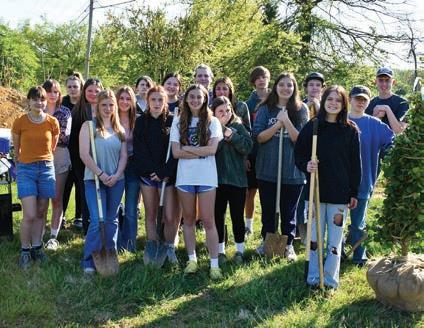
3 minute read
Allegheny Serviceberry Named Tree of the Year
Representatives from the State Arboretum of Virginia at Blandy Experimental Farm have named the Allegheny serviceberry (Amelanchier laevis) as the 2023 Tree of the Year. The Arboretum’s 2023 Tree of the Year was selected after deliberation by Curator T’ai Roulston and Blandy arborists. Since 2019, the State Arboretum of Virginia has designated one extraordinary species of tree as its Tree of the Year.
In honor of Arbor Day, “the nation’s tree planting holiday,” Blandy arborists and representatives from the Department of Forestry will plant an Allegheny Serviceberry tree at the Arboretum on Friday, April 28. The tree will be added to a tree and shrub collection that dates to the 1930s.
Advertisement
“A vital part of our mission is to practice and promote tree education, science, and conservation,” said Roulston. “Through research and public programming, we want to share with everyone of all ages how important trees are to the environment.”
Four-season Interest
The Allegheny serviceberry, found native in Virginia, was chosen for its fourseason interest, according to Roulston. A small understory tree, it’s ideal for landscapes and grows to only 1525 feet tall.
The Allegheny serviceberry is one of the first trees at the arboretum to flower each spring when the delicate masses of white, fragrant flowers appear in mid April. Small, dark purple berry-like fruit arrives in the summer. Also commonly known as juneberries, the edible berries attract pollinators and are a food source for native bees and more than 40 species of birds.
The fall foliage of the Allegheny serviceberry, when the leaves turn an orange-red color, is outstanding as well. The tree’s attractive gray bark lends structure to the winter garden.
Juneberries Serves as Food Source for Wildlife, Humans
Native Americans would dry juneberries, similar in size and taste to blueberries, and mix them with meat to create a high-energy snack called pemmican. Recipes for juneberry pies and jams are easy to find. If you want to eat the berries, though, you’d better be fast. Birds, squirrels, and other wildlife also enjoy the fruit.
How the Allegheny Serviceberry Gets Its Name
For settlers in the colder climates of North America, the blooming of the serviceberry was a sign that the ground was thawing. Graves could now be dug for loved ones who had died during the cold winter months and burial “services” could commence.
In some areas, the serviceberry is called shadbush or shadblow. The tree got this name because it blooms around the same time that shad return to their spawning grounds in freshwater rivers and streams. Common names also include smooth shadbush, juneberry and shadberry.


On Arbor Day each year, the State Arboretum of Virginia honors one extraordinary species of tree as its
Tree of the Year. The goals of the program are to:
• Remind us of the value and environmental significance of trees in Virginia and beyond
• Educate the public about the variety of trees in Virginia
• Nurture a love of trees in all ages
• Promote important tree education, science, and conservation at the State Arboretum and elsewhere in Virginia
• Join with others in awe of the majesty of Virginia’s tree
In selecting the Tree of the Year, these key traits are considered:
• Does the tree have a compelling story or uniqueness? Does it have special characteristics –for example, color or leaf structure – that make the tree an interesting choice?
• Is the tree readily available for purchase in Virginia at most nurseries?

• Is the tree familiar to most gardeners?
• Is the tree easy to grow and nurture for nonprofessionals and will make a good addition to a residential landscape?
This is Blandy’s fifth pick for Tree of the Year. Past Trees of the Year include:
• 2022: American Sycamore (Platanus occidentalis)
• 2021: Pawpaw (Asimina triloba)
• 2020: Sassafras (Sassafras albidum)
• 2019: Eastern Redbud (Cercis canadensis)
The State Arboretum of Virginia is home to more than 6,000 woody trees and shrubs, including a unique 300-tree ginkgo grove and a 36-tree Cedar of Lebanon allée. The Arboretum staff and many volunteers help to thoughtfully grow the collection each year by planting new and replacement trees.
The Arboretum is part of Blandy Experimental Farm, a research field station for the University of Virginia’s Department of Environmental Sciences. Blandy Experimental Farm is on Route 50 in Clarke County, about 10 miles east of Winchester and 20 miles west of Middleburg. Directions and a calendar of events are online at blandy.virginia.edu.
Summer Riding Camps Starting June 19









